HLTENN007: Administering and Monitoring of Medicines - Nursing Report
VerifiedAdded on 2023/01/10
|11
|2139
|94
Report
AI Summary
This report provides a comprehensive overview of administering and monitoring medicines, focusing on key aspects relevant to nursing practice. It begins by defining pharmacodynamics, the relationship between drug concentrations and their effects. The report then details the legal requirements for medication administration, including the roles of enrolled nurses and the importance of adhering to professional standards. It explores various topics such as the Visual Infusion Phlebitis Score (VIPS), medical schedules, and the rights associated with medication administration. Furthermore, it examines different intravenous (IV) medication administration methods, including bolus, drip infusion, and electronic pump infusions, along with their respective indications. The report also covers factors to consider when using drug administration aids, the uses and side effects of specific medications like Metoprolol, and the procedures for blood transportation, storage, and handling. Additionally, it discusses adverse reactions to blood transfusions and how to manage them, factors in calculating medication dosages, and concludes with a discussion on pain assessment. The report includes references to support the information presented.
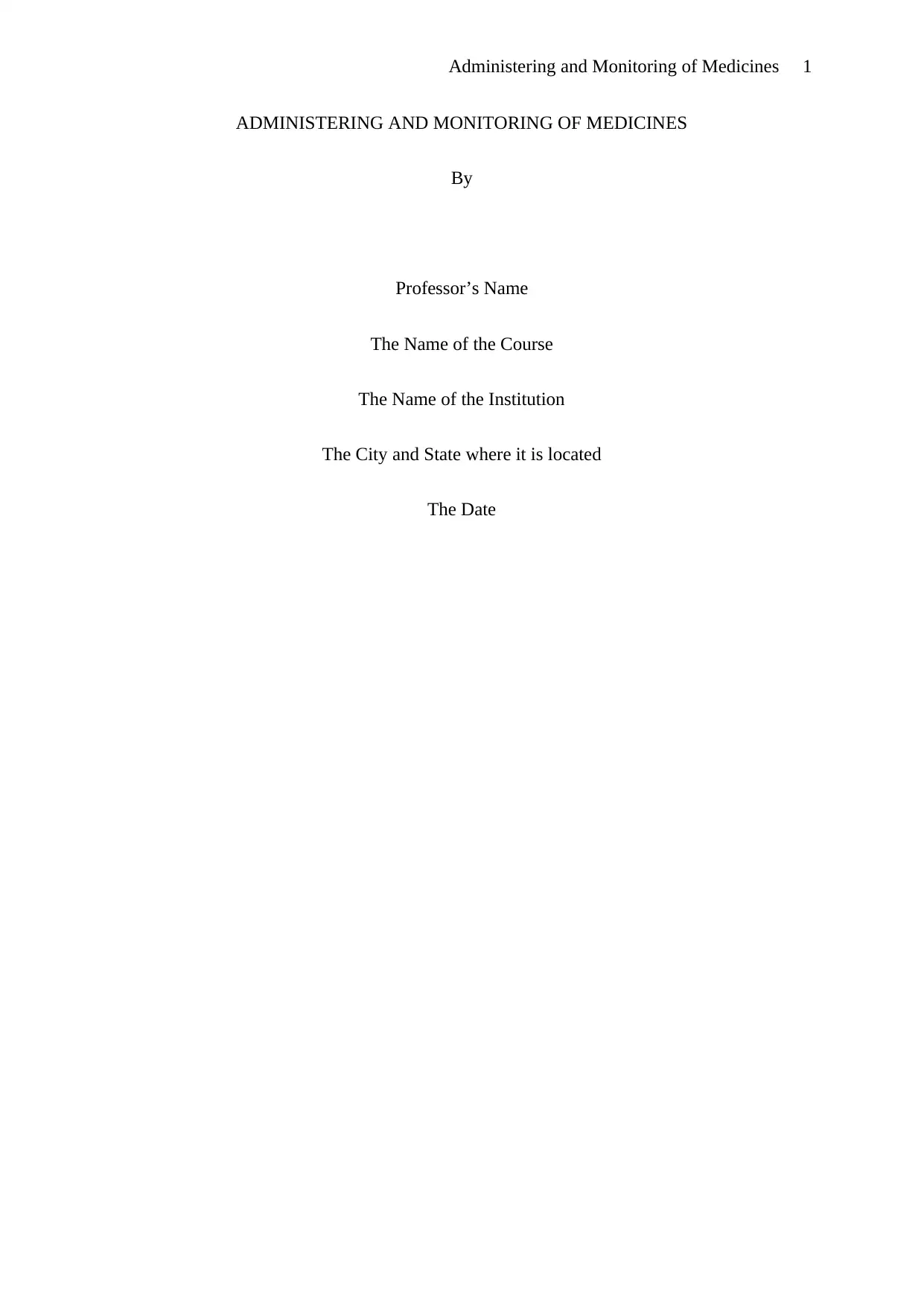
Administering and Monitoring of Medicines 1
ADMINISTERING AND MONITORING OF MEDICINES
By
Professor’s Name
The Name of the Course
The Name of the Institution
The City and State where it is located
The Date
ADMINISTERING AND MONITORING OF MEDICINES
By
Professor’s Name
The Name of the Course
The Name of the Institution
The City and State where it is located
The Date
Paraphrase This Document
Need a fresh take? Get an instant paraphrase of this document with our AI Paraphraser
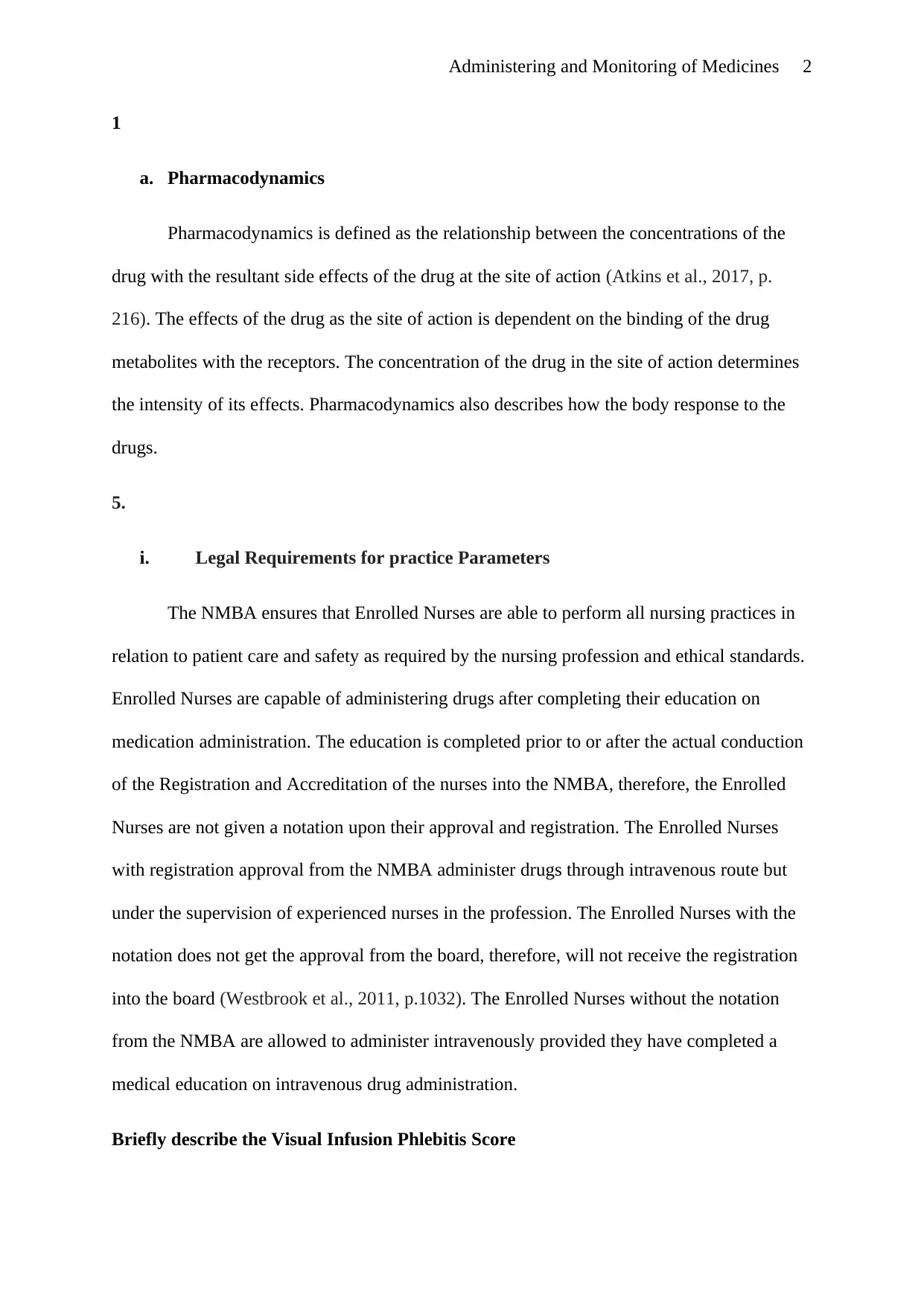
Administering and Monitoring of Medicines 2
1
a. Pharmacodynamics
Pharmacodynamics is defined as the relationship between the concentrations of the
drug with the resultant side effects of the drug at the site of action (Atkins et al., 2017, p.
216). The effects of the drug as the site of action is dependent on the binding of the drug
metabolites with the receptors. The concentration of the drug in the site of action determines
the intensity of its effects. Pharmacodynamics also describes how the body response to the
drugs.
5.
i. Legal Requirements for practice Parameters
The NMBA ensures that Enrolled Nurses are able to perform all nursing practices in
relation to patient care and safety as required by the nursing profession and ethical standards.
Enrolled Nurses are capable of administering drugs after completing their education on
medication administration. The education is completed prior to or after the actual conduction
of the Registration and Accreditation of the nurses into the NMBA, therefore, the Enrolled
Nurses are not given a notation upon their approval and registration. The Enrolled Nurses
with registration approval from the NMBA administer drugs through intravenous route but
under the supervision of experienced nurses in the profession. The Enrolled Nurses with the
notation does not get the approval from the board, therefore, will not receive the registration
into the board (Westbrook et al., 2011, p.1032). The Enrolled Nurses without the notation
from the NMBA are allowed to administer intravenously provided they have completed a
medical education on intravenous drug administration.
Briefly describe the Visual Infusion Phlebitis Score
1
a. Pharmacodynamics
Pharmacodynamics is defined as the relationship between the concentrations of the
drug with the resultant side effects of the drug at the site of action (Atkins et al., 2017, p.
216). The effects of the drug as the site of action is dependent on the binding of the drug
metabolites with the receptors. The concentration of the drug in the site of action determines
the intensity of its effects. Pharmacodynamics also describes how the body response to the
drugs.
5.
i. Legal Requirements for practice Parameters
The NMBA ensures that Enrolled Nurses are able to perform all nursing practices in
relation to patient care and safety as required by the nursing profession and ethical standards.
Enrolled Nurses are capable of administering drugs after completing their education on
medication administration. The education is completed prior to or after the actual conduction
of the Registration and Accreditation of the nurses into the NMBA, therefore, the Enrolled
Nurses are not given a notation upon their approval and registration. The Enrolled Nurses
with registration approval from the NMBA administer drugs through intravenous route but
under the supervision of experienced nurses in the profession. The Enrolled Nurses with the
notation does not get the approval from the board, therefore, will not receive the registration
into the board (Westbrook et al., 2011, p.1032). The Enrolled Nurses without the notation
from the NMBA are allowed to administer intravenously provided they have completed a
medical education on intravenous drug administration.
Briefly describe the Visual Infusion Phlebitis Score
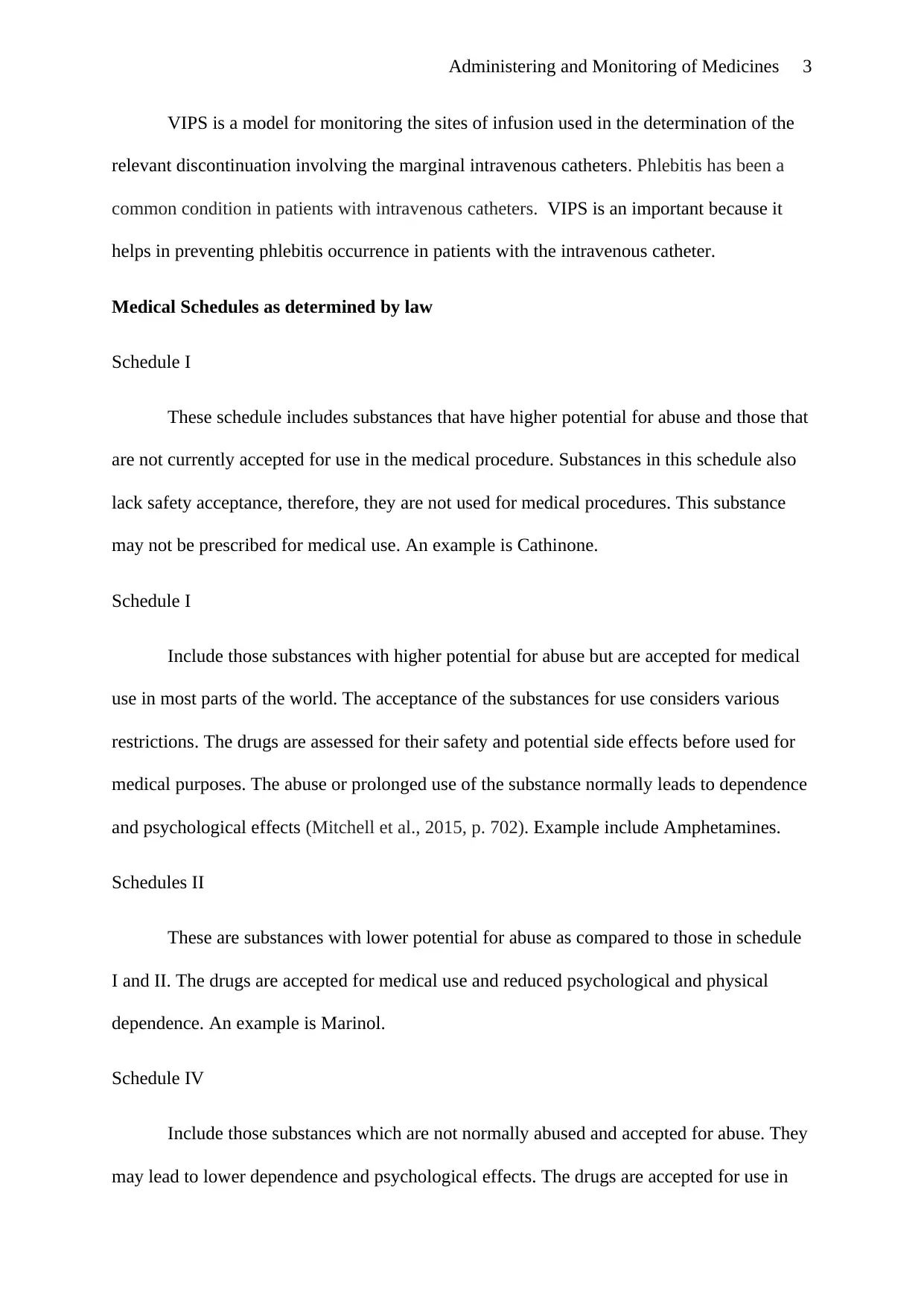
Administering and Monitoring of Medicines 3
VIPS is a model for monitoring the sites of infusion used in the determination of the
relevant discontinuation involving the marginal intravenous catheters. Phlebitis has been a
common condition in patients with intravenous catheters. VIPS is an important because it
helps in preventing phlebitis occurrence in patients with the intravenous catheter.
Medical Schedules as determined by law
Schedule I
These schedule includes substances that have higher potential for abuse and those that
are not currently accepted for use in the medical procedure. Substances in this schedule also
lack safety acceptance, therefore, they are not used for medical procedures. This substance
may not be prescribed for medical use. An example is Cathinone.
Schedule I
Include those substances with higher potential for abuse but are accepted for medical
use in most parts of the world. The acceptance of the substances for use considers various
restrictions. The drugs are assessed for their safety and potential side effects before used for
medical purposes. The abuse or prolonged use of the substance normally leads to dependence
and psychological effects (Mitchell et al., 2015, p. 702). Example include Amphetamines.
Schedules II
These are substances with lower potential for abuse as compared to those in schedule
I and II. The drugs are accepted for medical use and reduced psychological and physical
dependence. An example is Marinol.
Schedule IV
Include those substances which are not normally abused and accepted for abuse. They
may lead to lower dependence and psychological effects. The drugs are accepted for use in
VIPS is a model for monitoring the sites of infusion used in the determination of the
relevant discontinuation involving the marginal intravenous catheters. Phlebitis has been a
common condition in patients with intravenous catheters. VIPS is an important because it
helps in preventing phlebitis occurrence in patients with the intravenous catheter.
Medical Schedules as determined by law
Schedule I
These schedule includes substances that have higher potential for abuse and those that
are not currently accepted for use in the medical procedure. Substances in this schedule also
lack safety acceptance, therefore, they are not used for medical procedures. This substance
may not be prescribed for medical use. An example is Cathinone.
Schedule I
Include those substances with higher potential for abuse but are accepted for medical
use in most parts of the world. The acceptance of the substances for use considers various
restrictions. The drugs are assessed for their safety and potential side effects before used for
medical purposes. The abuse or prolonged use of the substance normally leads to dependence
and psychological effects (Mitchell et al., 2015, p. 702). Example include Amphetamines.
Schedules II
These are substances with lower potential for abuse as compared to those in schedule
I and II. The drugs are accepted for medical use and reduced psychological and physical
dependence. An example is Marinol.
Schedule IV
Include those substances which are not normally abused and accepted for abuse. They
may lead to lower dependence and psychological effects. The drugs are accepted for use in
⊘ This is a preview!⊘
Do you want full access?
Subscribe today to unlock all pages.

Trusted by 1+ million students worldwide
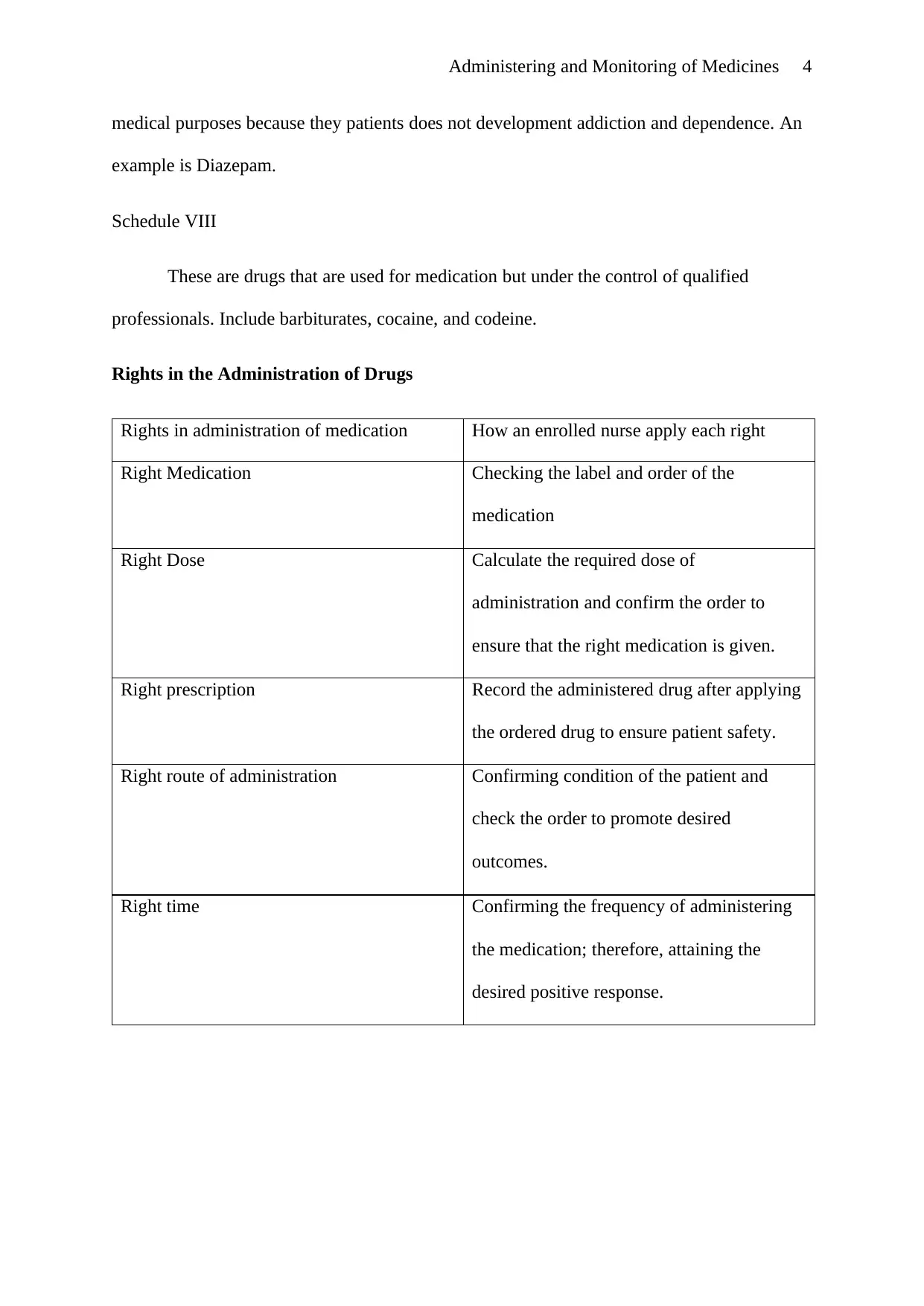
Administering and Monitoring of Medicines 4
medical purposes because they patients does not development addiction and dependence. An
example is Diazepam.
Schedule VIII
These are drugs that are used for medication but under the control of qualified
professionals. Include barbiturates, cocaine, and codeine.
Rights in the Administration of Drugs
Rights in administration of medication How an enrolled nurse apply each right
Right Medication Checking the label and order of the
medication
Right Dose Calculate the required dose of
administration and confirm the order to
ensure that the right medication is given.
Right prescription Record the administered drug after applying
the ordered drug to ensure patient safety.
Right route of administration Confirming condition of the patient and
check the order to promote desired
outcomes.
Right time Confirming the frequency of administering
the medication; therefore, attaining the
desired positive response.
medical purposes because they patients does not development addiction and dependence. An
example is Diazepam.
Schedule VIII
These are drugs that are used for medication but under the control of qualified
professionals. Include barbiturates, cocaine, and codeine.
Rights in the Administration of Drugs
Rights in administration of medication How an enrolled nurse apply each right
Right Medication Checking the label and order of the
medication
Right Dose Calculate the required dose of
administration and confirm the order to
ensure that the right medication is given.
Right prescription Record the administered drug after applying
the ordered drug to ensure patient safety.
Right route of administration Confirming condition of the patient and
check the order to promote desired
outcomes.
Right time Confirming the frequency of administering
the medication; therefore, attaining the
desired positive response.
Paraphrase This Document
Need a fresh take? Get an instant paraphrase of this document with our AI Paraphraser
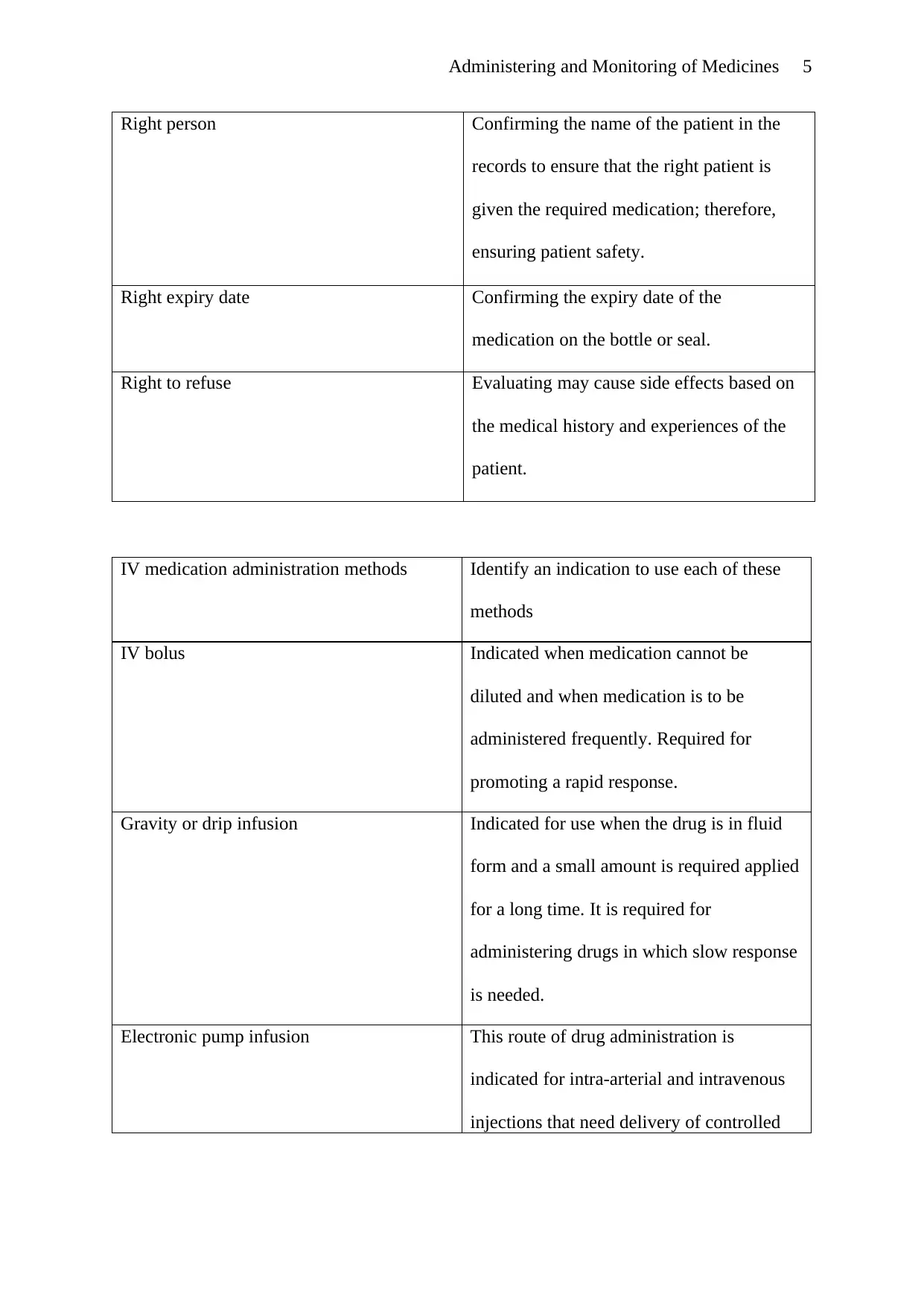
Administering and Monitoring of Medicines 5
Right person Confirming the name of the patient in the
records to ensure that the right patient is
given the required medication; therefore,
ensuring patient safety.
Right expiry date Confirming the expiry date of the
medication on the bottle or seal.
Right to refuse Evaluating may cause side effects based on
the medical history and experiences of the
patient.
IV medication administration methods Identify an indication to use each of these
methods
IV bolus Indicated when medication cannot be
diluted and when medication is to be
administered frequently. Required for
promoting a rapid response.
Gravity or drip infusion Indicated for use when the drug is in fluid
form and a small amount is required applied
for a long time. It is required for
administering drugs in which slow response
is needed.
Electronic pump infusion This route of drug administration is
indicated for intra-arterial and intravenous
injections that need delivery of controlled
Right person Confirming the name of the patient in the
records to ensure that the right patient is
given the required medication; therefore,
ensuring patient safety.
Right expiry date Confirming the expiry date of the
medication on the bottle or seal.
Right to refuse Evaluating may cause side effects based on
the medical history and experiences of the
patient.
IV medication administration methods Identify an indication to use each of these
methods
IV bolus Indicated when medication cannot be
diluted and when medication is to be
administered frequently. Required for
promoting a rapid response.
Gravity or drip infusion Indicated for use when the drug is in fluid
form and a small amount is required applied
for a long time. It is required for
administering drugs in which slow response
is needed.
Electronic pump infusion This route of drug administration is
indicated for intra-arterial and intravenous
injections that need delivery of controlled
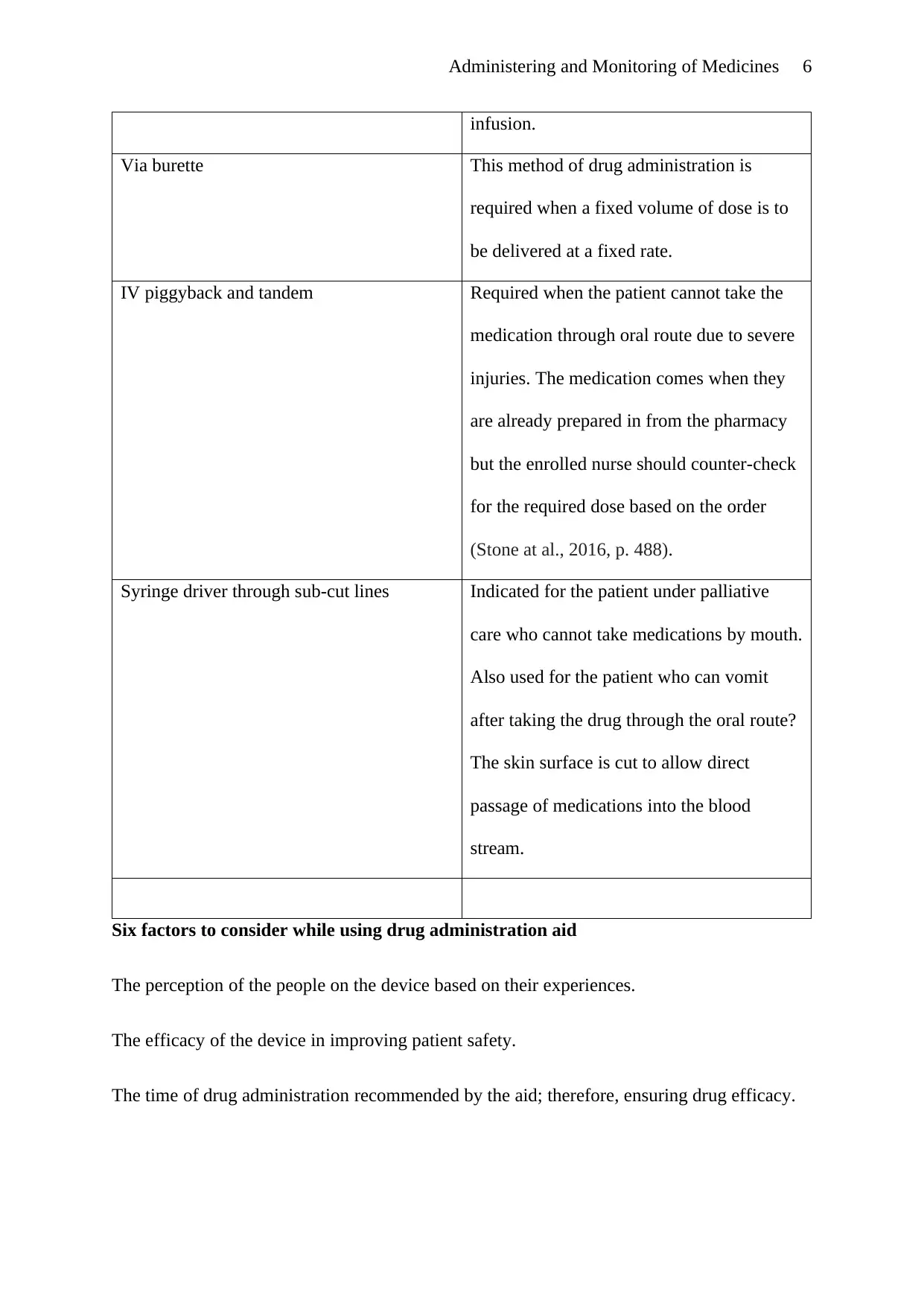
Administering and Monitoring of Medicines 6
infusion.
Via burette This method of drug administration is
required when a fixed volume of dose is to
be delivered at a fixed rate.
IV piggyback and tandem Required when the patient cannot take the
medication through oral route due to severe
injuries. The medication comes when they
are already prepared in from the pharmacy
but the enrolled nurse should counter-check
for the required dose based on the order
(Stone at al., 2016, p. 488).
Syringe driver through sub-cut lines Indicated for the patient under palliative
care who cannot take medications by mouth.
Also used for the patient who can vomit
after taking the drug through the oral route?
The skin surface is cut to allow direct
passage of medications into the blood
stream.
Six factors to consider while using drug administration aid
The perception of the people on the device based on their experiences.
The efficacy of the device in improving patient safety.
The time of drug administration recommended by the aid; therefore, ensuring drug efficacy.
infusion.
Via burette This method of drug administration is
required when a fixed volume of dose is to
be delivered at a fixed rate.
IV piggyback and tandem Required when the patient cannot take the
medication through oral route due to severe
injuries. The medication comes when they
are already prepared in from the pharmacy
but the enrolled nurse should counter-check
for the required dose based on the order
(Stone at al., 2016, p. 488).
Syringe driver through sub-cut lines Indicated for the patient under palliative
care who cannot take medications by mouth.
Also used for the patient who can vomit
after taking the drug through the oral route?
The skin surface is cut to allow direct
passage of medications into the blood
stream.
Six factors to consider while using drug administration aid
The perception of the people on the device based on their experiences.
The efficacy of the device in improving patient safety.
The time of drug administration recommended by the aid; therefore, ensuring drug efficacy.
⊘ This is a preview!⊘
Do you want full access?
Subscribe today to unlock all pages.

Trusted by 1+ million students worldwide
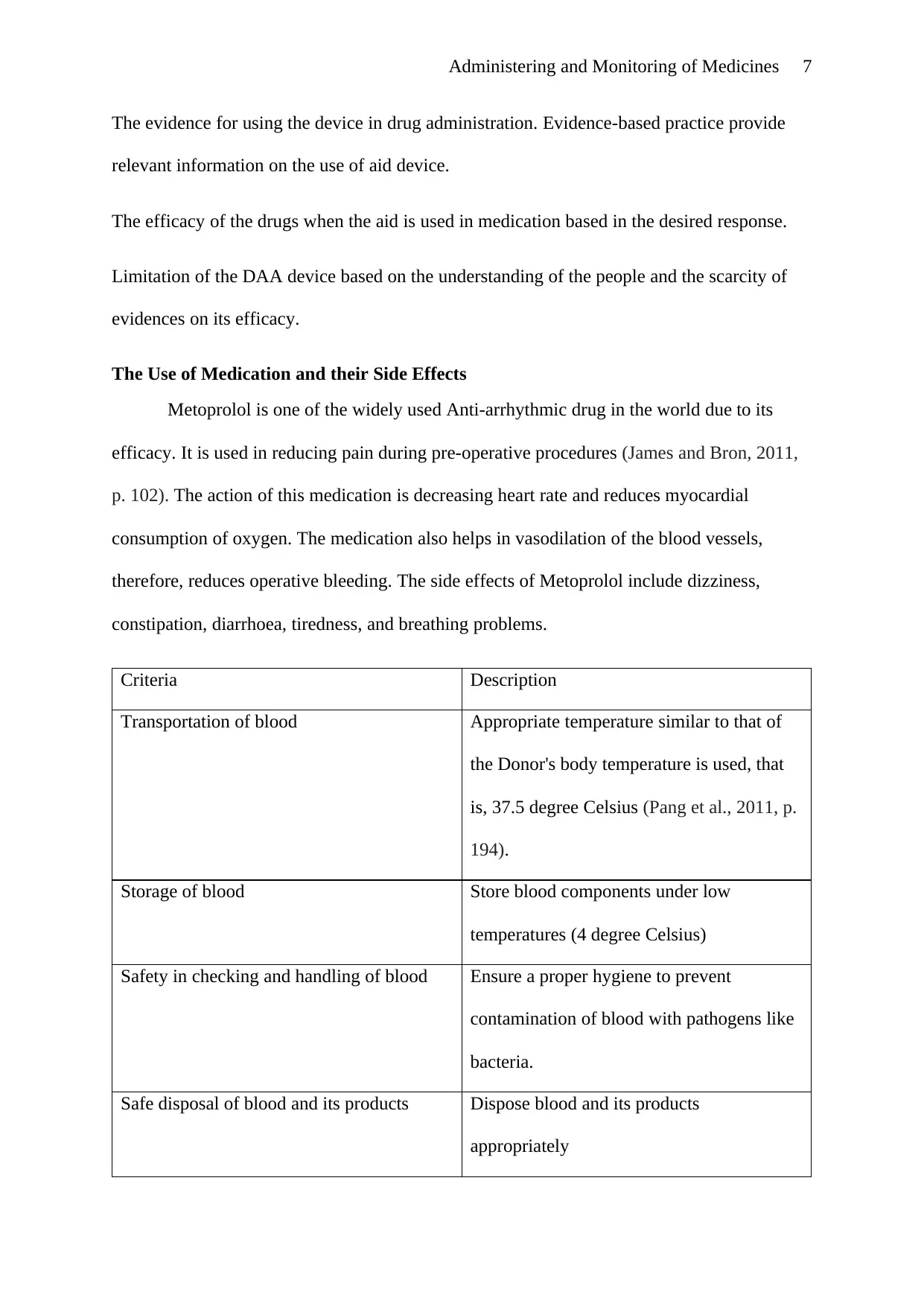
Administering and Monitoring of Medicines 7
The evidence for using the device in drug administration. Evidence-based practice provide
relevant information on the use of aid device.
The efficacy of the drugs when the aid is used in medication based in the desired response.
Limitation of the DAA device based on the understanding of the people and the scarcity of
evidences on its efficacy.
The Use of Medication and their Side Effects
Metoprolol is one of the widely used Anti-arrhythmic drug in the world due to its
efficacy. It is used in reducing pain during pre-operative procedures (James and Bron, 2011,
p. 102). The action of this medication is decreasing heart rate and reduces myocardial
consumption of oxygen. The medication also helps in vasodilation of the blood vessels,
therefore, reduces operative bleeding. The side effects of Metoprolol include dizziness,
constipation, diarrhoea, tiredness, and breathing problems.
Criteria Description
Transportation of blood Appropriate temperature similar to that of
the Donor's body temperature is used, that
is, 37.5 degree Celsius (Pang et al., 2011, p.
194).
Storage of blood Store blood components under low
temperatures (4 degree Celsius)
Safety in checking and handling of blood Ensure a proper hygiene to prevent
contamination of blood with pathogens like
bacteria.
Safe disposal of blood and its products Dispose blood and its products
appropriately
The evidence for using the device in drug administration. Evidence-based practice provide
relevant information on the use of aid device.
The efficacy of the drugs when the aid is used in medication based in the desired response.
Limitation of the DAA device based on the understanding of the people and the scarcity of
evidences on its efficacy.
The Use of Medication and their Side Effects
Metoprolol is one of the widely used Anti-arrhythmic drug in the world due to its
efficacy. It is used in reducing pain during pre-operative procedures (James and Bron, 2011,
p. 102). The action of this medication is decreasing heart rate and reduces myocardial
consumption of oxygen. The medication also helps in vasodilation of the blood vessels,
therefore, reduces operative bleeding. The side effects of Metoprolol include dizziness,
constipation, diarrhoea, tiredness, and breathing problems.
Criteria Description
Transportation of blood Appropriate temperature similar to that of
the Donor's body temperature is used, that
is, 37.5 degree Celsius (Pang et al., 2011, p.
194).
Storage of blood Store blood components under low
temperatures (4 degree Celsius)
Safety in checking and handling of blood Ensure a proper hygiene to prevent
contamination of blood with pathogens like
bacteria.
Safe disposal of blood and its products Dispose blood and its products
appropriately
Paraphrase This Document
Need a fresh take? Get an instant paraphrase of this document with our AI Paraphraser
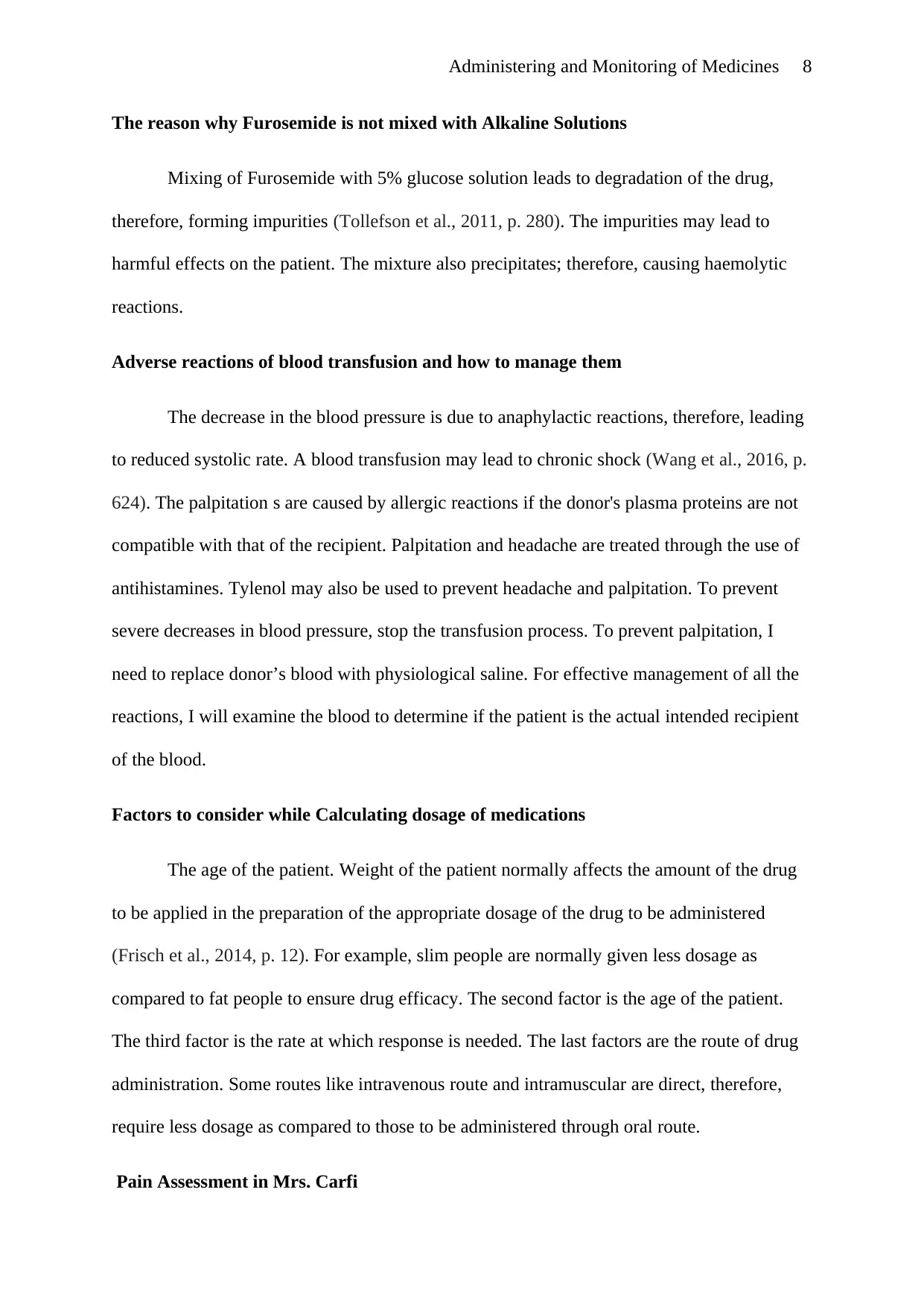
Administering and Monitoring of Medicines 8
The reason why Furosemide is not mixed with Alkaline Solutions
Mixing of Furosemide with 5% glucose solution leads to degradation of the drug,
therefore, forming impurities (Tollefson et al., 2011, p. 280). The impurities may lead to
harmful effects on the patient. The mixture also precipitates; therefore, causing haemolytic
reactions.
Adverse reactions of blood transfusion and how to manage them
The decrease in the blood pressure is due to anaphylactic reactions, therefore, leading
to reduced systolic rate. A blood transfusion may lead to chronic shock (Wang et al., 2016, p.
624). The palpitation s are caused by allergic reactions if the donor's plasma proteins are not
compatible with that of the recipient. Palpitation and headache are treated through the use of
antihistamines. Tylenol may also be used to prevent headache and palpitation. To prevent
severe decreases in blood pressure, stop the transfusion process. To prevent palpitation, I
need to replace donor’s blood with physiological saline. For effective management of all the
reactions, I will examine the blood to determine if the patient is the actual intended recipient
of the blood.
Factors to consider while Calculating dosage of medications
The age of the patient. Weight of the patient normally affects the amount of the drug
to be applied in the preparation of the appropriate dosage of the drug to be administered
(Frisch et al., 2014, p. 12). For example, slim people are normally given less dosage as
compared to fat people to ensure drug efficacy. The second factor is the age of the patient.
The third factor is the rate at which response is needed. The last factors are the route of drug
administration. Some routes like intravenous route and intramuscular are direct, therefore,
require less dosage as compared to those to be administered through oral route.
Pain Assessment in Mrs. Carfi
The reason why Furosemide is not mixed with Alkaline Solutions
Mixing of Furosemide with 5% glucose solution leads to degradation of the drug,
therefore, forming impurities (Tollefson et al., 2011, p. 280). The impurities may lead to
harmful effects on the patient. The mixture also precipitates; therefore, causing haemolytic
reactions.
Adverse reactions of blood transfusion and how to manage them
The decrease in the blood pressure is due to anaphylactic reactions, therefore, leading
to reduced systolic rate. A blood transfusion may lead to chronic shock (Wang et al., 2016, p.
624). The palpitation s are caused by allergic reactions if the donor's plasma proteins are not
compatible with that of the recipient. Palpitation and headache are treated through the use of
antihistamines. Tylenol may also be used to prevent headache and palpitation. To prevent
severe decreases in blood pressure, stop the transfusion process. To prevent palpitation, I
need to replace donor’s blood with physiological saline. For effective management of all the
reactions, I will examine the blood to determine if the patient is the actual intended recipient
of the blood.
Factors to consider while Calculating dosage of medications
The age of the patient. Weight of the patient normally affects the amount of the drug
to be applied in the preparation of the appropriate dosage of the drug to be administered
(Frisch et al., 2014, p. 12). For example, slim people are normally given less dosage as
compared to fat people to ensure drug efficacy. The second factor is the age of the patient.
The third factor is the rate at which response is needed. The last factors are the route of drug
administration. Some routes like intravenous route and intramuscular are direct, therefore,
require less dosage as compared to those to be administered through oral route.
Pain Assessment in Mrs. Carfi
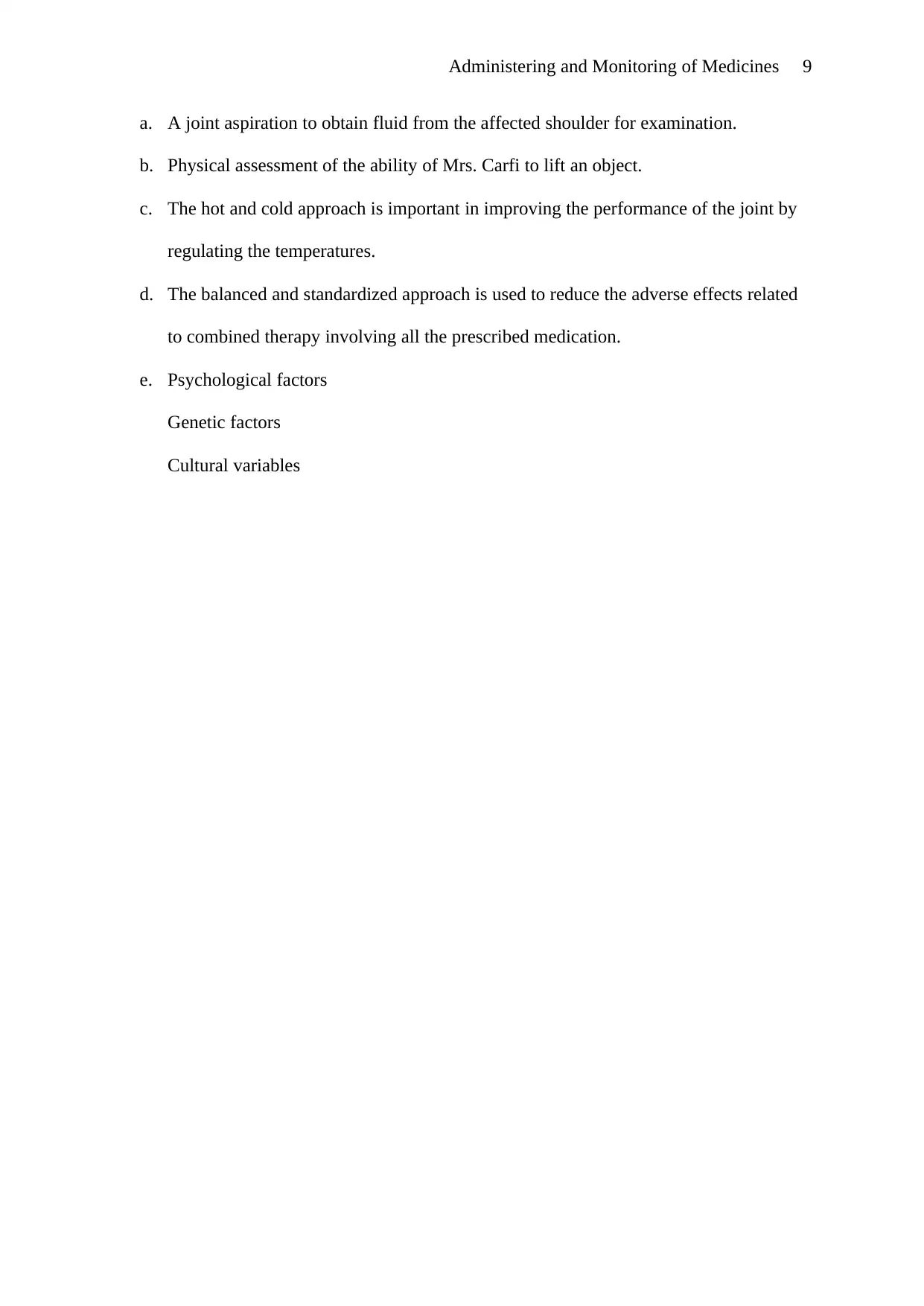
Administering and Monitoring of Medicines 9
a. A joint aspiration to obtain fluid from the affected shoulder for examination.
b. Physical assessment of the ability of Mrs. Carfi to lift an object.
c. The hot and cold approach is important in improving the performance of the joint by
regulating the temperatures.
d. The balanced and standardized approach is used to reduce the adverse effects related
to combined therapy involving all the prescribed medication.
e. Psychological factors
Genetic factors
Cultural variables
a. A joint aspiration to obtain fluid from the affected shoulder for examination.
b. Physical assessment of the ability of Mrs. Carfi to lift an object.
c. The hot and cold approach is important in improving the performance of the joint by
regulating the temperatures.
d. The balanced and standardized approach is used to reduce the adverse effects related
to combined therapy involving all the prescribed medication.
e. Psychological factors
Genetic factors
Cultural variables
⊘ This is a preview!⊘
Do you want full access?
Subscribe today to unlock all pages.

Trusted by 1+ million students worldwide
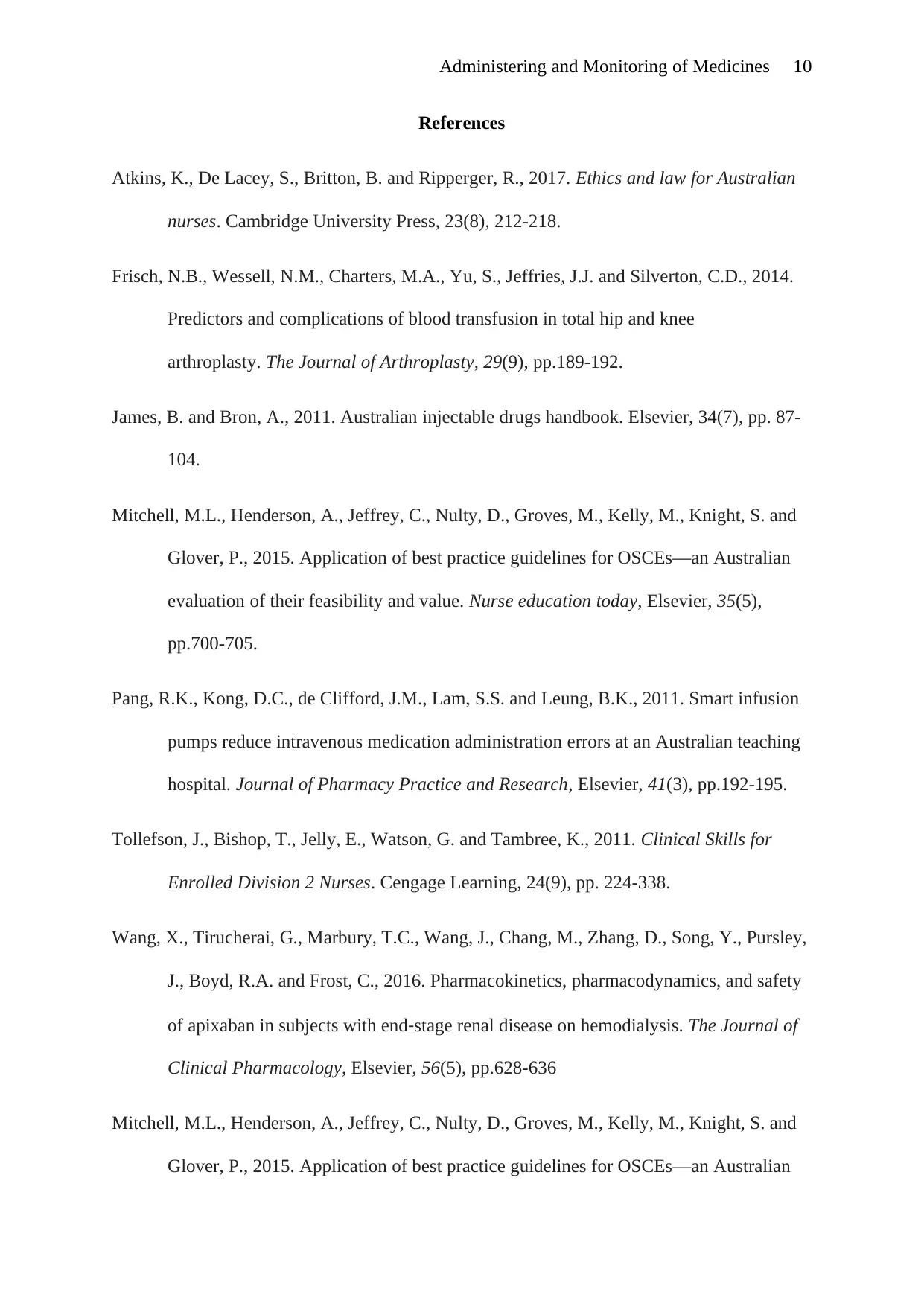
Administering and Monitoring of Medicines 10
References
Atkins, K., De Lacey, S., Britton, B. and Ripperger, R., 2017. Ethics and law for Australian
nurses. Cambridge University Press, 23(8), 212-218.
Frisch, N.B., Wessell, N.M., Charters, M.A., Yu, S., Jeffries, J.J. and Silverton, C.D., 2014.
Predictors and complications of blood transfusion in total hip and knee
arthroplasty. The Journal of Arthroplasty, 29(9), pp.189-192.
James, B. and Bron, A., 2011. Australian injectable drugs handbook. Elsevier, 34(7), pp. 87-
104.
Mitchell, M.L., Henderson, A., Jeffrey, C., Nulty, D., Groves, M., Kelly, M., Knight, S. and
Glover, P., 2015. Application of best practice guidelines for OSCEs—an Australian
evaluation of their feasibility and value. Nurse education today, Elsevier, 35(5),
pp.700-705.
Pang, R.K., Kong, D.C., de Clifford, J.M., Lam, S.S. and Leung, B.K., 2011. Smart infusion
pumps reduce intravenous medication administration errors at an Australian teaching
hospital. Journal of Pharmacy Practice and Research, Elsevier, 41(3), pp.192-195.
Tollefson, J., Bishop, T., Jelly, E., Watson, G. and Tambree, K., 2011. Clinical Skills for
Enrolled Division 2 Nurses. Cengage Learning, 24(9), pp. 224-338.
Wang, X., Tirucherai, G., Marbury, T.C., Wang, J., Chang, M., Zhang, D., Song, Y., Pursley,
J., Boyd, R.A. and Frost, C., 2016. Pharmacokinetics, pharmacodynamics, and safety
of apixaban in subjects with end‐stage renal disease on hemodialysis. The Journal of
Clinical Pharmacology, Elsevier, 56(5), pp.628-636
Mitchell, M.L., Henderson, A., Jeffrey, C., Nulty, D., Groves, M., Kelly, M., Knight, S. and
Glover, P., 2015. Application of best practice guidelines for OSCEs—an Australian
References
Atkins, K., De Lacey, S., Britton, B. and Ripperger, R., 2017. Ethics and law for Australian
nurses. Cambridge University Press, 23(8), 212-218.
Frisch, N.B., Wessell, N.M., Charters, M.A., Yu, S., Jeffries, J.J. and Silverton, C.D., 2014.
Predictors and complications of blood transfusion in total hip and knee
arthroplasty. The Journal of Arthroplasty, 29(9), pp.189-192.
James, B. and Bron, A., 2011. Australian injectable drugs handbook. Elsevier, 34(7), pp. 87-
104.
Mitchell, M.L., Henderson, A., Jeffrey, C., Nulty, D., Groves, M., Kelly, M., Knight, S. and
Glover, P., 2015. Application of best practice guidelines for OSCEs—an Australian
evaluation of their feasibility and value. Nurse education today, Elsevier, 35(5),
pp.700-705.
Pang, R.K., Kong, D.C., de Clifford, J.M., Lam, S.S. and Leung, B.K., 2011. Smart infusion
pumps reduce intravenous medication administration errors at an Australian teaching
hospital. Journal of Pharmacy Practice and Research, Elsevier, 41(3), pp.192-195.
Tollefson, J., Bishop, T., Jelly, E., Watson, G. and Tambree, K., 2011. Clinical Skills for
Enrolled Division 2 Nurses. Cengage Learning, 24(9), pp. 224-338.
Wang, X., Tirucherai, G., Marbury, T.C., Wang, J., Chang, M., Zhang, D., Song, Y., Pursley,
J., Boyd, R.A. and Frost, C., 2016. Pharmacokinetics, pharmacodynamics, and safety
of apixaban in subjects with end‐stage renal disease on hemodialysis. The Journal of
Clinical Pharmacology, Elsevier, 56(5), pp.628-636
Mitchell, M.L., Henderson, A., Jeffrey, C., Nulty, D., Groves, M., Kelly, M., Knight, S. and
Glover, P., 2015. Application of best practice guidelines for OSCEs—an Australian
Paraphrase This Document
Need a fresh take? Get an instant paraphrase of this document with our AI Paraphraser

Administering and Monitoring of Medicines 11
evaluation of their feasibility and value. Nurse education today, Elsevier, 35(5),
pp.700-705.
evaluation of their feasibility and value. Nurse education today, Elsevier, 35(5),
pp.700-705.
1 out of 11
Related Documents
Your All-in-One AI-Powered Toolkit for Academic Success.
+13062052269
info@desklib.com
Available 24*7 on WhatsApp / Email
![[object Object]](/_next/static/media/star-bottom.7253800d.svg)
Unlock your academic potential
Copyright © 2020–2025 A2Z Services. All Rights Reserved. Developed and managed by ZUCOL.





